RAF100: Airfix 1/72 Handley-Page Victor B. Mk. 2
Following the success of the wartime Halifax, Handley Page began looking at jet power for bombers; a tail-less swept wing design became their pet project, which got the interest of the Air Ministry and in early 1947 an official specification. B.35/46, was issued to cover development of what Handley Page designated the HP.80, which added a T tail. It would be one of the three “V-bombers” and an initial service date of 1951 was called for. The crescent-shaped wing was created to increase speed by preventing drag rise as the wing approached Mach 1.
Handley Page tested their crescent wing and tail design, using a Supermarine Type 510 fuselage designated type 521 by Supermarine. The fuselage was married to crescent-shaped wings and a T-tail, and was known as the HP.88. Coded VX330, it flew too late to be of use in the Victor program and was lost in an accident on August 26th, 1951, killing pilot Duggie Broomfield.
The first HP.80, WB771, flew for the first time on December 24, 1952. In comparison to the Vulcan and Valiant, it had a larger bomb bay and a very different crew compartment, with the pressurized crew compartment extended to the tip of the nose. In common with the Valiant and Vulcan, only the pilots had ejector seats. Thus, in an emergency, the pilots could get out while the rear crew died, given there was really no way to bale out of the side hatch right in front of the engine intakes; the B.Mk.2, which was longer, had the hatch further forward of the intakes and there were some successful escapes by back-seaters however.
During tests of the prototypes, Handley Page's test pilots returning from flights over the North Sea would often “forget” to notify Air Traffic control that they were returning at maximum speed and altitude in a straight line for the UK. The only fighters that could intercept them - and did - were the F-101 Voodoos of the 81st TFW, which showed how impressive the Victor was.
The first Victor B.1 flew on February 1, 1956. Fitted with more powerful Sapphire engines than used in the prototypes, the cleared maximum speed of Mach 0.95 proved pessimistic when test pilot Johnny Allam inadvertently achieved Mach 1.1 in a very shallow dive! Bomber Command became operational with the Victor in April 1958.
In late 1955, Handley Page proposed an improved Mk.2 variant. Despite it becoming obvious that the future of bombing was a low-level under-the-radar attack, the B.2 was a “fly higher, fly faster” design. Following cancellation of the much higher thrust Sapphire 9 engines, Rolls-Royce Conways were adopted, requiring redesign of the wing roots, intakes and engine boxes. With wingspan expanded by an insert in the wing and a larger wingtip, changed tailcone, all-new electrical system and many other modifications, the first B.2 flew in February 1959.
The B-2 entered service just in time to stand alert during the Cuban Missile Crisis in 1962. The final B.2 off the production line was delivered to the RAF in May 1963. The role soon changed to low-level bombing in 1964, and with appropriate green and grey camouflage replacing the earlier anti-flash white, XL513 being the first changed, with a one-off scheme different from what would become standard, and the B.2 force was also equipped with the Blue Steel nuclear missile.
1963 saw the first hint of action for the Victor when several were deployed to Singapore in December as a show of force during the confrontation with Indonesia over Malaysia. Indonesia backed down when further Victors were deployed in 1964.
In 1966, XL513, which had deployed to Australia, suffered a bomb-bay fire on the return flight and was forced to land at Gan in the Maldives south of India. A team from Handley Page went out and re-wired the bomb-bay. 139 Squadron technician Tom Muir recalled, “We went out to service and check out all the aircraft systems. After a fire, re-wire, five weeks on the ground in tropical salt-laden air, there were many crossed fingers when she gingerly took to the air again. We must have done a reasonable job as she flew safely home none the worse for her ordeal.”
Revell released a 1/72 Victor K-2 in the early 1980s, this being the Matchbox tooling, which was the only plastic kit of this aircraft until Airfix released this B.2 in 2016. They have now released the kit as a Victor K.2 tanker. This kit is the only one to depict the bomber. There was a very old Lindberg release in 1/96 scale of the prototype HP.80 back in the late 1950s.
The kit is thoroughly “new Airfix,” with quality moldings and good kit design. The now-standard excellent Airfix instruction booklet clearly shows what new parts are the subject of each logical step of construction; this is very helpful with a kit that is as complex (but not complicated!) as this is.
A detailed cockpit is barely visible if one opens the side hatch to allow light inside. Two different aircraft - one in the overall white anti-flash scheme, and one in the later camouflage scheme, are supplied in the decal sheet along with extensive in-scale stenciling.
Xtradecals released sheet 72265 with several Victor bombers, including XL513 with its unique markings and scheme.
This is a big model, even in 1/72, and swinging it around as one progresses through the build will break off small details. I highly recommend that the wing pitot tubes and all antennas be left until the final step in your assembly. That way, you won't have to make new pitots from Evergreen rod, as I did.
That said, if you take the radical step of following the instructions, you will have a trouble-free build. Everything fits, and the ultimate result looks good.
I painted the cockpit interior without going into great detail, since one can really only see the pilot's seats once everything is installed and assembled. I also painted the interior of the air intakes white before further assembly. Finally, I attached the landing gear as early on as possible, so the model could sit. It requires plenty of weight in the nose, and the fish weights completely filled the area below the cockpit floor.
I followed the paint scheme for XL513 in the Xtradecals instructions, using Tamiya Gloss White, and Tamiya Sea Grey Medium and RAF Dark Green. Looking at a photo of XL513, it is clear it was not done with the “hard edge” camo scheme, so I was able to freehand the scheme. I gave it some weathering so it would look like the original had looked after its five weeks in the tropical Maldives.
The kit decals were used for the national markings and the stenciling. Fortunately four “light” roundels were included on the sheet, so I could apply a double thickness for the fuselage markings; the decals were not opaque enough to deal with the various camouflage colors they were applied over. Fortunately, the upper wing insignia was sufficiently opaque. I finally gave up on all the stenciling halfway through, given their small size; you can barely see them once applied.
I painted the landing gear and wheel bays with Tamiya Flat aluminum, and applied a coat of Micro-Scale Satin overall, to give the model the “gloss” finish of the time, but in scale.
I have always thought the Victor was the most interesting of the three V-bombers in terms of its aerodynamic shape - it even gives the Vulcan a run for its money in terms of aerial aesthetics. This kit by Airfix is not difficult, though I would recommend it only to intermediate modelers and above, due to its complexity. My suspicion is the K.2 release will prove more popular. Highly recommended.
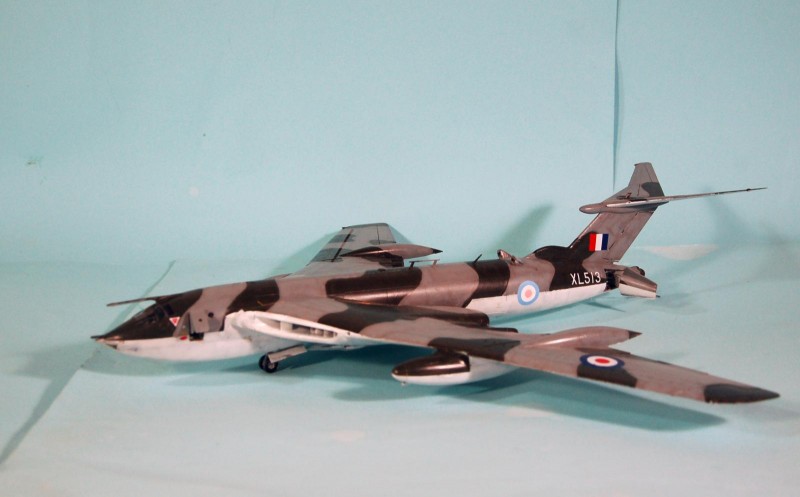
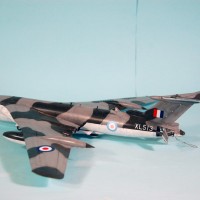
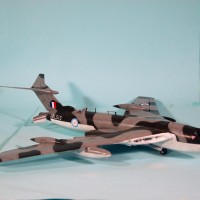
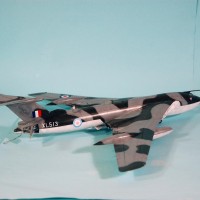
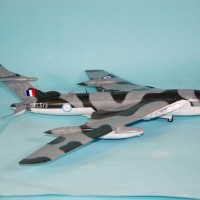

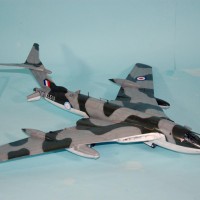
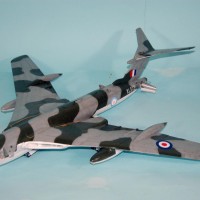
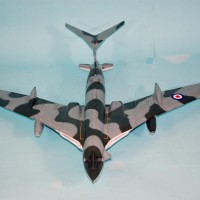
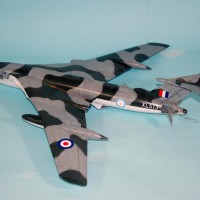
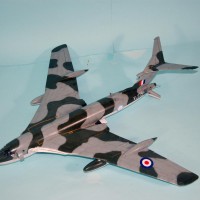
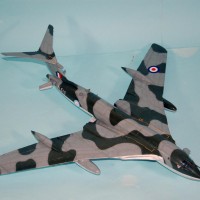
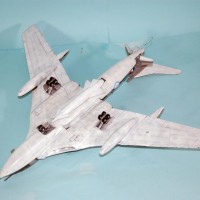
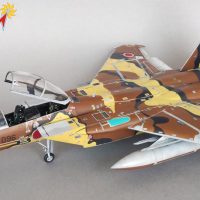
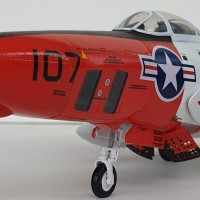
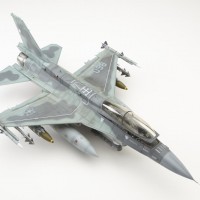

Great narrative, beautiful Victor.
‘Liked’
Having a very Flash Gordon-esque design the Victor was way cooler than the other two V-bombers. The Vulcan had elán but not the same sort of brutal look. Thanks for interesting background story.
An elegant build, looks great!
Very nice Tom - I've toyed with adding one of these to the stash, but the size has kept me from doing so to date. I don't know than any of my display cases could contain it!
Nice job, Tom. I have a little more to do on mine and will post it during the reveal in December.
Good-lookin' build, TC...
Outstanding Victor, Tom! I like your narratives, too. I always find something to learn!
That's a VERY handsome aircraft.
Great Job Tom, looks spot on! Really like the way the preshading stays subtle enough but still adds character without overwhelming the overall feel. Top notch!
I watched Vulcans in flypasts over London countless times in the 70s and 80s and at Biggin. Incredible to see in the air - especially at airshows before there was quite so much rigour in terms of 'health and safety' and they swooped low over the crowds. My dad always took us to the airshows at Biggin Hill. My first was 1974 I remember the Vulcan and Meteor, Harriers and a Phantom. In '78 I think there was a Vampire, and '79 an A10 that stole the show, and again the Vulcan. But in 75 there was a Victor and a group of Lightnings. Although the lightnings took it for me, and it is a distant memory - the Victor (a K1a) looked pretty much like your model!
Great to see. Brilliant build and history!
Hello Tom,
Thanks for sharing this "first Airfix Victor"on Imodeler.
It looks great. I did read your comprehensive article.
That gives also a idea about constructing this major model.
Regards, Dirk / The Netherlands.
I'd say that you could easily take that to Telford!
Really cool build! The painting and the weathering are spot on, I think you nailed that one!
Superb job, I'm going to finish up my projects then that one's first in the stash. Thanks for the inspiration!